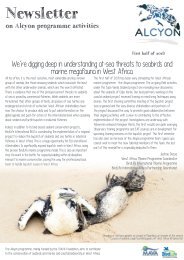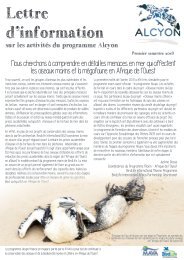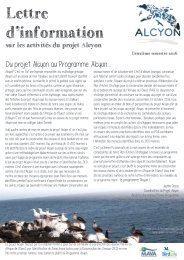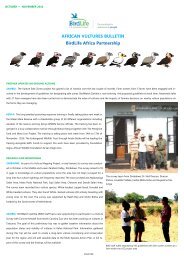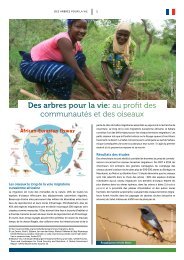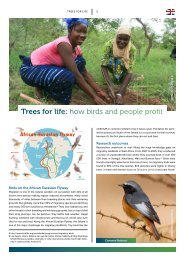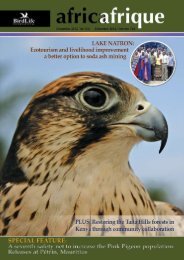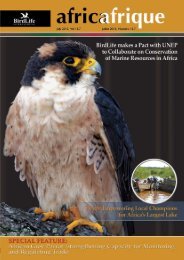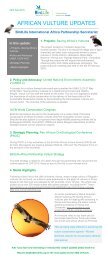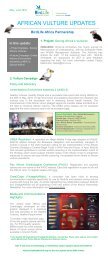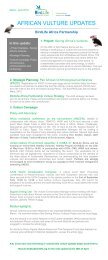ALcyon Newsletter-January 2017 - EN
ALcyon Newsletter-January 2017 - EN
ALcyon Newsletter-January 2017 - EN
You also want an ePaper? Increase the reach of your titles
YUMPU automatically turns print PDFs into web optimized ePapers that Google loves.
<strong>Newsletter</strong><br />
on Alcyon project activities<br />
Alcyon? It is, in fact, a legend borrowed from Greek mythology. Alcyon is a<br />
fabulous seabird, with plaintive song (often identified with the kingfisher,<br />
gull, petrel or swan), which is considered a good omen by Greeks and<br />
poets because according to legend it only builds its nest on a calm sea.<br />
We had hoped at the start of the Alcyon project that seabirds and all<br />
marine and coastal biodiversity of our sub-region, threatened by various<br />
pressures, would nest, just like Alcyon, on the calm marine environment<br />
of West Africa. This is what this project, named Alcyon by my former<br />
colleague Julien Semelin sets out to achieve.<br />
After four years of the Alcyon project, this is no longer a dream. It is, in<br />
fact thanks to the Alcyon project that light has been shed on key sites<br />
for the conservation of birds and biodiversity at sea; what we call marine<br />
Important Bird and Biodiversity Areas - marine IBAs. Yes, a network of<br />
13 marine IBAs has been identified as part of the Alcyon project, off our<br />
sub-region through well-developed methodology based on strict criteria<br />
followed by the BirdLife International Marine Programme team. However,<br />
the purpose of the Alcyon project was not only to focus on identifying<br />
marine IBAs. It is to reach a harmonious West African eco-region, like an<br />
Alcyon nest on a calm sea. At this stage, it is more than necessary to<br />
put in place appropriate measures to address the threats identified while<br />
further knowledge is gathered on other risks that might impede better<br />
conservation of seabirds and biodiversity.<br />
Second half of 2016<br />
From the Alcyon project towards an Alcyon Programme...<br />
For this reason, the project team has begun a process to develop a<br />
Regional Strategy and Action Plan (SAP) for seabird and marine biodiversity<br />
sustainable conservation off the coast of West Africa. This strategy<br />
paper would make it possible to build on the Alcyon project achievements<br />
in order to sustain conservation of the resources concerned.<br />
In October 2016, we organized a workshop for wrapping up and future<br />
prospects of the Alcyon project to take stock of project achievements,<br />
present the strategy paper developed, and to seek contributions from<br />
stakeholders, local partners, international experts, and policy makers to<br />
better consider the strategic action needed to address the risks and<br />
threats identified in the SAP. Undoubtedly, implementing the priority action<br />
identified in this SAP will contribute effectively to reducing impact in the<br />
long-term and even eliminating the threats identified in marine IBAs.<br />
It is precisely continuing implementation of our Strategic Action Plan<br />
through a marine programme, which thanks to the overlap of the<br />
different components could achieve our objective. Alcyon will definitely<br />
no longer be a project, but rather the Seabird and marine conservation<br />
programme in West Africa. You will read news of this marine programme<br />
- the Alcyon programme in the next few issues of our <strong>Newsletter</strong> !<br />
Justine Dossa<br />
Alcyon Project Manager<br />
BirdLife International Marine Programme<br />
BirdLife International Africa Partnership Secretariat<br />
New coloniy of Red-footed Booby (Sula sula) on<br />
Raso Islet, Cape verde (© Biosfera)<br />
The goal of the Alcyon project funded by the MAVA Foundation is to contribute to the protection of seabirds in<br />
West Africa by identifying marine Important Bird and Biodiversity Areas (IBAs).<br />
From the next Issues, we will speak instead about the Alcyon Programme
The second half of 2016 was marked by two important events<br />
for the Alcyon project: development of the Seabird Conservation<br />
Strategic Action Plan (SAP) along the West African East Atlantic<br />
Flyway, and the close participation of local partners, Experts,<br />
international organizations in the seabird symposium. This was<br />
organized by BirdLife International as part of wrapping up the<br />
Alcyon project.<br />
At the ending year of the Alcyon project implementation, a practical<br />
tool for addressing the issues and challenges ahead is through a<br />
Regional Strategy and Action Plan to ensure a long-term sustainable<br />
option. BirdLife is developing this Strategic Action Plan (SAP) for<br />
the West African sub-region (focusing on the CCLME region) to<br />
ensure that threats to seabirds (in the broadest sense) and marine<br />
conservation action are well matched, achievable, and carefully<br />
considered.<br />
The Pan-African Ornithological Congress (PAOC14) was the setting<br />
in which the Alcyon Project Team chose to present this SAP to key<br />
stakeholders, international experts and national decision makers;<br />
seek their input, and develop and discuss implementation strategies,<br />
through a seabird symposium and a Two day workshop. This<br />
workshop for the strategic action plan for seabird conservation<br />
along the West African East Atlantic Flyway gathered participants<br />
from most of the East Atlantic Flyway initiative countries.<br />
Participants from BirdLife partners, experts involved in the Alcyon<br />
project, supporting partners, local partners (with at least one<br />
participant from each CCLME country), potential partners from<br />
other initiatives involved in marine conservation in West Africa<br />
(including the CCLME project, Mamiwata Project, AWA Project,<br />
Marine Spatial Planning Project, oil and gas expert from the<br />
Benguela system, the Abidjan Convention, CSRP, PRCM), and potential<br />
donors (MAVA, CEPF, FAO) attended the two-day workshop, with<br />
around 60 participants. The report of this workshop, including the<br />
main recommendations can be found here.<br />
The seabird symposium (‘Managing impacts on seabirds from<br />
forage fisheries, bycatch and the depletion of stocks’) attracted<br />
participants from many countries working on seabird conservation<br />
issues in West Africa. Close to 100 PAOC participants came to<br />
Participants of the SAP workshop during a plenary session (© Dossa)<br />
Local partners discussing about specific strategic activities to their countries in<br />
working group, SAP workshop (© T. Dodman)<br />
the symposium, reflecting the interest in the relationship between<br />
seabird conservation and West African challenges. To sum up: Of<br />
the 28 presentations made during the symposium, 21 of them<br />
were delivered by Alcyon project partners (students trained by the<br />
project; local and external partners) and showed the project results.<br />
Also, seven posters were presented on the key results, one of<br />
which won the PAOC14 student poster award (prepared by Ngoné<br />
Diop, a Senegalese PhD student).<br />
In Senegal, our partners from the Department of<br />
National Parks of Senegal (DPN) launched, in the margins of the<br />
PAOC14, the exhibition which aims to improve the eco-tourism<br />
services provided by National Park of Iles de la Madeleine (PNIM) to<br />
Flock of Slender-billed Gulls, National Park of Saloum Delta, Senegal (© Dossa)
increase the spin-offs of eco-tourism in order to ensure funding<br />
of long-term conservation of the park’s birds. BirdLife, through its<br />
Alcyon project, provided technical support and financed the PNIM<br />
for this exhibition which allowed the creation of a logo specific to<br />
PNIM and a bank of images presented on outreach activities on<br />
which PNIM and its resources have been developed.<br />
Colonel Souleye Ndiaye, Director of the National Parks of Senegal,<br />
reiterated his great satisfaction with the collaboration between<br />
the DPN and BirdLife International through the Alcyon project<br />
for seabird conservation activities in several Protected Areas of<br />
Senegal. After rapid assessment of the change observed since the<br />
exhibition was set up last October, the park team believes that<br />
this exhibition is very appreciated by visitors although it is too early<br />
(only 3 months on) to evaluate the change in terms of economic<br />
spin-offs. The conservator of PNIM recognizes that «based only<br />
on visitor feedback, it can already be confirmed that the exhibition<br />
plays a very important role in gaining customer satisfaction at the<br />
outset even before arriving in the field. Of the 42 suggestions<br />
submitted to the park’s suggestion box, 88% of the visitors were<br />
very satisfied and expressed the wish to come back as soon as<br />
possible”.<br />
Colonel Souleye Ndiaye, Director of DPN, Senegal giving the official speech at the<br />
launch of PNIM exhibition (© Dossa)<br />
Training observers and scientists to understand interaction between<br />
seabirds and fishing activities<br />
One of Alcyon project activities is to assess interaction between<br />
seabirds and artisanal and commercial fisheries. Training fisheries<br />
observers in how and why to collect relevant data is an important<br />
step to achieving that goal. Specialist training includes seabird<br />
identification and scientific approaches to data collection.<br />
Between 30 August-1 September the Alcyon Project Team together<br />
with Yann Tremblay (IRD, France) provided training to 20 scientists<br />
and fisheries observers, covering West African East Atlantic Flyway<br />
seabirds, seabird ecology, seabird identification, at-sea observation of<br />
live birds and the collection of important data while out at sea.<br />
Captain Mame Abdou Faye, PNIM Deputy Curator presents the exhibition to the<br />
guests at the launch ceremony (© Dossa)<br />
Most of the observers are well-trained with respect to fish and<br />
fishing operations. They have, collectively, spent decades at sea as<br />
observers; monitoring catches on trips that last between two weeks<br />
and two months. And now, thanks to BirdLife’s initiatives, they are<br />
becoming seabird observers.<br />
Practice sessions on the identification of seabirds during the training of observers (© Dossa)
In Cape Verde, all local partners, administrative<br />
authorities, PA managers and key external partners involved in<br />
seabird conservation in the country (including Sociedade Portuguesa<br />
para o Estudodas Aves- SPEA, University of Coimbra, Portugal,<br />
University of Barcelona, Spain) are actively preparing with BirdLife<br />
International their action plans for better conservation of seabirds<br />
in the archipelago. In view of the special importance of this country<br />
to conserve seabirds and the insular nature of Cape Verde, BirdLife<br />
International will coordinate a single action plan with partners for<br />
seabird conservation in Cape Verde, which will be implemented<br />
thanks to the support of our biggest ally, the MAVA Foundation.<br />
All local NGOs throughout the archipelago, and state institutions,<br />
in collaboration with external partners and BirdLife International<br />
will join forces to work together for this. This will represent<br />
a separate component in our new marine programme. More<br />
information in the next issue.<br />
Juvenile of Brown Booby, Sula leucogaster on Raso Islet, Cape Verde (© Biosfera)<br />
Off the coast of West Africa, a<br />
network of 13 marine IBAs has been identified after intensive<br />
data analysis gathered during the life of the Alcyon project. For a<br />
decade, BirdLife partners in over 40 countries have been working<br />
to identify marine IBAs as priority sites for seabird conservation. To<br />
date, over 3,500 IBAs have been identified for seabirds, including<br />
120 IBAs on the high seas, covering 6.5% of oceans. Criteria have<br />
been discussed and approved to ensure that marine IBAs could be<br />
identified in a consistent and comparable way at global scale.<br />
West Africa has not been left out of this marine IBAs process;<br />
indeed, this is the ultimate goal of the Alcyon project. Thanks to the<br />
project, 13 marine IBAs totalling 7,264,608 ha have been identified<br />
during the life of the project from Morocco to Guinea-Bissau<br />
including Cape Verde. The BIMP team has prepared an overall report<br />
on the detailed description on the identification of marine IBAs at<br />
sea in West Africa. This report presents the methodology used to<br />
identify the marine IBAs, with a detailed description of each site,<br />
Chick of Cape Verde Shearwater (Calonectris edwardsii)<br />
on Raso Islet, Cape Verde (© Biosfera)<br />
including justification of the boundaries and a list of species. Country<br />
reports have also been prepared and shared (translated in each<br />
country language as appropriate).<br />
The next step is to work with local partners to integrate these<br />
marine IBAs into the various mechanisms that exist by promoting<br />
their use as tools to address the different conservation problems<br />
in the sub-region. This step has started and a series of feedback<br />
workshops on the process is being organised in each Country.<br />
.<br />
Upcoming events<br />
BirdLife International World Congress. Singapore, 9-14 October <strong>2017</strong>. The Alcyon team is preparing a side event on seabird and<br />
marine conservation in West Africa. More soon on our webpage.<br />
BirdLife will shortly recruit project officers for different components of the Alcyon Programme. The job description will be<br />
advertised on our website very soon.<br />
For further information :<br />
Justine Dossa<br />
Alcyon Project Manager<br />
justine.dossa@birdlife.org<br />
www.birdlife.org



